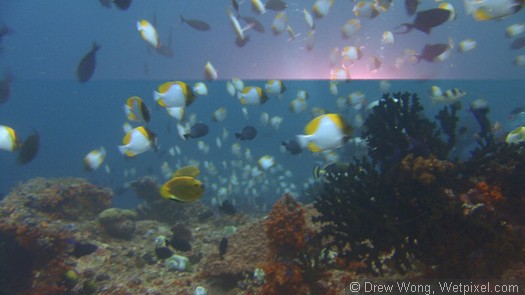Gates FX7/V1 housing for the Sony HDR-FX7 and HVR-V1U review
The camera setup I used for this test was similar to the previous review I wrote. With this trip, the CMOS sensor rolling shutter effect was very apparent due to the many strobes firing while I was shooting. When the strobe fires, the rolling shutter of the sensor can be caught in mid-scan. This can lead to partial frame exposures whereby part of the frame is exposed normally but the other part have inputs mid-scan (see pic). The partial frame exposure issue can be dealt with in post by whiting out the errant frames or a more complex job of frame blending. To lower the chance of this happening, using faster shutter speeds generally helps but this is not always possible under water.

The rolling shuter issue: If a strobe fires directly onto the sensor in mid-scan, the frame can partially expose the new input for part of the frame…

...then pick up the remnants of the strong light source in the next frame, rending both frames unacceptable
As with other external monitors, the Gates EM43 did not work if I had on screen markings on so I had to keep it off. Peaking and zebra did not show but the histogram was available. Of the previous settings, the notable changes are:
Assign Button 2: OIS on/off/ OIS: Soft
With access to the assign button, I wanted to experiment with OIS for macro shooting, especially with Pygmy Seahorses. However with OIS, if you are using a tripod, the system can sometimes want to compensate when there is nothing to stabilize causing jumps. In unsupported shooting, the OIS in soft setting actually did help slightly in certain conditions such as shooting nudibranchs in current etc.
Black Compensation: Stretch
To get the best latitude out of the picture, I used the Stretch mode so I could control light better in post. This is also for guys for who broadcast so the post guys can have the shadow details for post production. For shooters who produce DVDs at the end of the dive day, I personally think Compress would give a better contrasty picture without much post.
Shutter Speed: 1/60 or higher
In 30P mode, the V1 defaults to 1/30 shutter speed, which is great for low light shooting. However, shooting the faster moving subjects means 1/30 would give you a blurred image. I was caught with this a few times and decided to lock it at 1/60 and keep it in manual.
Gain limit: 9db With 1/60 shutter speed , the V1 loses about ¾ stop so I raised the gain limit to 9db from 6db. 9db has a bit more noise but is acceptable.
Quick Rec: ON The biggest complaint I have about HDV cameras is the tape drum has to be spooling at full speed before it starts recording. This can take 5-6 seconds. So I turned this on, risking the broken time code, which now modern NLEs can capture regardless of timecode breaks.
Overall, the HVR-V1 is a good underwater camera. The progressive scan sensors capture a nice image with higher resolution (especially in 1080p) than the FX1/Z1. It isn’t as light sensitive but the 1080p picture makes up for a lot at just 1 stop loss of sensitivity. And with the higher resolution, there is more detail in high gain. The 20x lens is great for supermacro with a diopter attached. It’s not very wide at 35mm but most housings for it have great WA options. Furthermore, it’s the most compact of the 3x sensor HDV cameras, with an average housing weight savings of over 25% over the bigger counterparts. It isn’t the best performing HDV camera but it does compare well against the competitors for performance underwater considering its size.